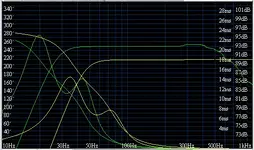Oh, and about the sine wave sweep...
Unfortunately, that's not a very good method. Room resonances build up while you're taking the measurement, and the graph such a method would produce will be much worse looking than actual transient performance.
The preffered method is an MLS measurement, which requires some sophisticated software. There is a freeware package called Speaker Workshop that will actually do this for you, but it's not easy to do! There's a learning curve involved. Also, you'll need a super flat omni measurement mic. Fortunately
a Behringer ECM 8000 is just the ticket!
Basically, an MLS measurement consists of a short burst of pink noise. The computer records the response from the speaker and only analyzes to the tiny moment of sound before the first reflection hits the microphone. That way, only the direct sound is anayzed with no reflections, and therefore no room effects. Effectively, this is as good as using an anechoic chamber.
While this is the preferred method, you can see how this can be problematic for a sub! A sub operates at very long wavelengths, and it's response relies heavily on boundary reflections, room modes, standing waves, etc etc... So even if you have a sub that measures flat using any method you can name, it may not sound that way!
Basically, what I do is design the sub to be flat by design, and the crossover to the mains the be similarly flat. Then play with room placement, level, crossover frequencies and slopes. Take some measurements, but most of all, listen to it!
You're never going to get "repeatability" or "customer translatability" in the sub-bass region like you can get with the main speakers, but you can at least work with a system that is world class.... and that's a lot better than just forgetting about the low bass entirely!



 My ears are actually quite sensitive to low frequencies. I can usually hear the "thump" of a helicopter well before its "chop" becomes audible and I can hear the port on all but the best ported speakers. I suppose that's why I took up the bass.
My ears are actually quite sensitive to low frequencies. I can usually hear the "thump" of a helicopter well before its "chop" becomes audible and I can hear the port on all but the best ported speakers. I suppose that's why I took up the bass.
